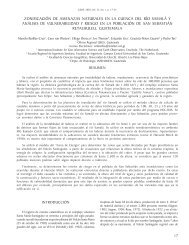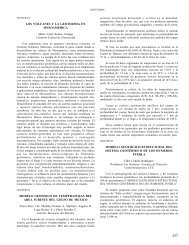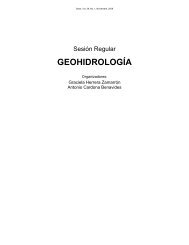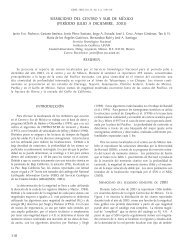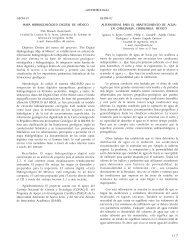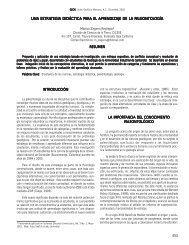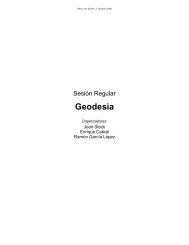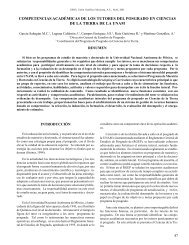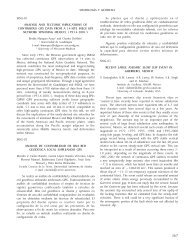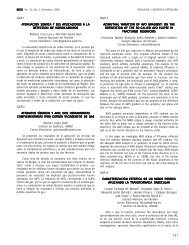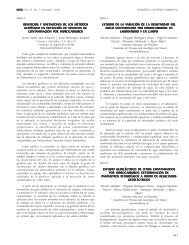Libro de Resúmenes - Unión Geofisica Mexicana AC
Libro de Resúmenes - Unión Geofisica Mexicana AC
Libro de Resúmenes - Unión Geofisica Mexicana AC
Create successful ePaper yourself
Turn your PDF publications into a flip-book with our unique Google optimized e-Paper software.
EL SISMO DE BAJA CALIFORNIA (MW 7.2) DEL 4 DE ABRIL DE 2010 Geos, Vol. 30, No. 1, Noviembre, 2010<br />
SE05-1<br />
SURF<strong>AC</strong>E RUPTURES ASSOCIATED WITH THE<br />
EL MAYOR-CUCAPAH EARTHQUAKE SEQUENCE<br />
Fletcher John 1 , Rockwell Tom 2 , Teran Orlando 1 , Masana Eulalia 3 , Faneros Geoff 2 ,<br />
Hudnut Ken 4 , González Javier 1 , González Alejandro 1 , Spelz Ronald 1 , Mueller<br />
Karl 5 , Chung Ling-ho 5 , Akciz Sinan 6 , Galetzka John 7 , Stock Joann 7 y Scharer Kate 7<br />
1 CICESE<br />
2 SDSU<br />
3 U. <strong>de</strong> Barcelona<br />
4 USGS<br />
5 U. <strong>de</strong> Colorado<br />
6 U. <strong>de</strong> California, Irvine<br />
7 Cal. Tech.<br />
jfletche@cicese.mx<br />
Surface rupture associated with the April 4, 2010 El Mayor-Borrego earthquake<br />
extends ~100 km from the northern tip of the Gulf of California to the international<br />
bor<strong>de</strong>r and comprises two distinct geomorphologic and structural domains. The<br />
rupture is complex, with breaks along multiple fault strands, including minor<br />
re-rupture of the scarps associated with the 1892 Laguna Salada earthquake and<br />
several other ol<strong>de</strong>r events. The southern half of the rupture consists of a zone<br />
of distributed fracturing and liquifaction cuts across the Colorado River <strong>de</strong>lta.<br />
Individual fractures vary wi<strong>de</strong>ly in orientation and have relatively short strike<br />
lengths of the or<strong>de</strong>r of hundreds of meters. The zone itself may be related to<br />
faults that bound the eastern margin of the Sierra El Mayor, but field relationships<br />
are unclear, and the zone of more intense fracturing diverges significantly from<br />
the mountain front toward the south. The northern half of the rupture propagated<br />
55 km through an imbricate stack of east-dipping faults in the the Sierra Cucapah.<br />
In the southern Sierra Cucapah, rupture extends 20 km along the Laguna Salada<br />
and Pescadores faults and reached a maximum displacement of ~ 250 cm of<br />
right-lateral strike-slip. The amount of dip slip is variable and changes polarity<br />
along strike along the Laguna Salada Fault before becoming predominantly<br />
east-down with maximum offsets of 150 cm along the Pescadores Fault . This<br />
ruptured terminates in the high elevations of the sierra and jumps nearly 10<br />
km north in a left stepover to the Borrego fault. Additionally the Laguna Salada<br />
fault rebroke with minor (10-30 cm) dip slip along a segment that is adjacent<br />
to the primary Borrego rupture.Maximum measured displacement along the<br />
Borrego fault in Borrego Valley was about 3.1 m of strike slip and another 2<br />
m of down-to-the-east dip slip on a nearly vertical fault, yielding oblique slip of<br />
nearly 4 m. A low-angle <strong>de</strong>tachment intersects the footwall of the central portion<br />
of the Borrego fault at a segment boundary, and rupture bifurcates with a splay<br />
that follows the trace of the <strong>de</strong>tachment in a more westerly direction. Over the<br />
next 6 km to the north, rupture steps left across a 2km wi<strong>de</strong> zone before finally<br />
consolidating on a fault that we have named the Paso Superior Fault and extends<br />
~10 km to the north. The Paso Superior is well-exposed at Highway 2, where<br />
it is clearly a low-angle <strong>de</strong>tachment. Scarps near the fault trace accommodate<br />
dip slip and nearly twice as much strike-slip is spread across a 100-150 m wi<strong>de</strong><br />
zone of cracking and secondary faulting to the east.<br />
Part of the complexity of the rupture can be attributed to interaction with<br />
<strong>de</strong>tachment faults that allow the rupture to expand in the near surface. This<br />
rupture illustrates the complexity that can <strong>de</strong>velop when a rupture propagates<br />
through a network of high- and-low angle faults that accommodate the<br />
three-dimensional strain of transtensional plate margin shearing.<br />
SE05-2<br />
RASGOS GEOLÓGICOS Y DISTRIBUCIÓN DE DAÑOS EN<br />
EL VALLE DE MEXICALI CAUSADOS POR EL TEMBLOR<br />
“EL MAYOR-CUCAPAH” M=7.2 DEL 4 DE ABRIL DE 2010<br />
Suárez Vidal Francisco 1 , Mendoza Borunda Ramón 1 , Ramírez Hernán<strong>de</strong>z<br />
Jorge 2 , Vázquez Hernán<strong>de</strong>z Sergio 1 , Glowacka Ewa 1 y Mendoza Garcilazo Luis 1<br />
1 CICESE<br />
2 UABC<br />
fsuarez@cicese.mx<br />
Veinte cuatro horas <strong>de</strong>spués <strong>de</strong> la ocurrencia <strong>de</strong>l sismo <strong>de</strong> M= 7.2 conocido<br />
como El Mayor-Cucapah el 4 <strong>de</strong> Abril <strong>de</strong> 2010 se visitó la región <strong>de</strong>l Valle <strong>de</strong><br />
Mexicali; el objetivo, obtener evi<strong>de</strong>ncias y documentar los rasgos geológicos<br />
generados por el sismo en la región <strong>de</strong>l epicentro, así como en la mayor parte<br />
<strong>de</strong>l valle, y los daños a estructuras civiles en poblados y zona cultivada. Estos<br />
fueron severos en la región cercana la epicentros (e.g. Ejido Sonora, Nayarit,<br />
Durango Oaxaca, Delta, poblados <strong>de</strong> Zacamoto, Cucapah Mestizo) y en menor<br />
escala en dirección noreste <strong>de</strong>l epicnetro. Los daños mayores se asocian al<br />
proceso <strong>de</strong> licuefacción y al fracturamiento <strong>de</strong> la red <strong>de</strong> canales y drenes <strong>de</strong>l<br />
distrito <strong>de</strong> riego <strong>de</strong>l Valle <strong>de</strong> Mexicali.<br />
La combinación <strong>de</strong> la magnitud <strong>de</strong>l temblor y la naturaleza <strong>de</strong>l subsuelo somero<br />
(10 metros) constituido <strong>de</strong> arenas <strong>de</strong> grano fino y arcillas saturadas, provocó<br />
que los sedimentos se licuaran y fueran extruidos en forma <strong>de</strong> volcanes <strong>de</strong><br />
arena, con gran<strong>de</strong>s cantida<strong>de</strong>s <strong>de</strong> agua, llegando a inundar poblados (Ejido<br />
Nayarit y Zacamoto), así como gran<strong>de</strong>s extensiones <strong>de</strong> terreno cultivado.<br />
El fracturamiento y <strong>de</strong>formación observada en la visita <strong>de</strong> campo, como en<br />
fotografías aéreas tomadas por INEGI días <strong>de</strong>spués <strong>de</strong> la ocurrencia <strong>de</strong>l sismo,<br />
se distribuye mayormente paralelo a los canales y drenes, generando ruptura <strong>de</strong><br />
estos, y igualmente afectando al sistema carretero que comunica a los diversos<br />
poblados en el valle. Las fracturas observadas se asocian a procesos extensivos<br />
y en algunos casos se observó fracturas con <strong>de</strong>splazamiento vertical <strong>de</strong>l or<strong>de</strong>n<br />
<strong>de</strong> centímetros. La orientación <strong>de</strong>l fracturamiento se concentra en un abanico<br />
NNE-NNW.<br />
La distribución <strong>de</strong> daños generados por el temblor <strong>de</strong>l 4 <strong>de</strong> Abril es amplia,<br />
incluye zonas inundadas por ruptura <strong>de</strong> canales <strong>de</strong> irrigación y licuefacción.<br />
Zonas enterradas por arena y arcilla expulsadas por el mismo proceso <strong>de</strong><br />
licuefacción. Más <strong>de</strong> 100 km <strong>de</strong>l sistema <strong>de</strong> carreteras afectado y que<br />
comunican al valle. Más <strong>de</strong> 60,000 hectáreas <strong>de</strong> terreno cultivado con trigo, listo<br />
para ser cosechado. Líneas <strong>de</strong>l tendido eléctrico en el valle afectadas y colapso<br />
parcial y total <strong>de</strong> casas y edificios en los poblados ejidales. Lo más importante<br />
25,000 a 35,000 personas esperando su relocalización.<br />
SE05-3<br />
EL RELIEVE A LO LARGO DE LA FALLA EN LA SIERRA<br />
CUCAPÁ: UNA PERSPECTIVA POR LEVANTAMIENTOS LIDAR<br />
DE ANTES Y DESPUÉS DEL SISMO MW 7.2 DEL 4 DE ABRIL<br />
Hinojosa Corona Alejandro 1 , Oskin Michael 2 , Gold Peter 2 , Elliot Austin 2 ,<br />
Taylor Michael 3 , Herrs Andrew J. 3 , Aerosmith Ramon 4 y Fletcher John 1<br />
1 CICESE<br />
2 UC Davis<br />
3 Unversity of Kansas<br />
4 ASU<br />
alhinc@cicese.mx<br />
El temblor <strong>de</strong>l 4 abril 2010 en el valle <strong>de</strong> Mexicali <strong>de</strong> magnitud 7.2 Mw, produjo<br />
rompimiento en superficie a lo largo <strong>de</strong> la falla. Por diferentes técnicas <strong>de</strong><br />
percepción remota se ha reportado <strong>de</strong>formación importante en la zona. Al<br />
norte <strong>de</strong> la sierra Cucapá se generaron <strong>de</strong>splazamientos cercanos a los +2m<br />
en la vertical con caída <strong>de</strong> bloques mayoritariamente hacia el este con una<br />
componente lateral <strong>de</strong>recha menor. Se analiza el relieve <strong>de</strong>l terreno antes y<br />
<strong>de</strong>spués <strong>de</strong>l temblor por medio <strong>de</strong> levantamientos Lidar aéreos y terrestres.<br />
Previo al evento, existe un mo<strong>de</strong>lo digital <strong>de</strong> elevación generado a partir<br />
un levantamiento aéreo Lidar. Doce días <strong>de</strong>spués <strong>de</strong>l temblor, se hizo un<br />
levantamiento Lidar terrestre con dos equipos a lo largo <strong>de</strong> un segmento <strong>de</strong><br />
1.5km <strong>de</strong> la falla al norte <strong>de</strong> la Sierra Cucapá, don<strong>de</strong> se observaron los mayores<br />
<strong>de</strong>splazamientos verticales. La <strong>de</strong>nsa nube <strong>de</strong> puntos sigue fielmente el relieve<br />
don<strong>de</strong> <strong>de</strong>staca con sorpren<strong>de</strong>nte <strong>de</strong>talle la estructura <strong>de</strong>l rompimiento. La<br />
reconstrucción 3D <strong>de</strong> las cicatrices frescas <strong>de</strong>l temblor ayudará a enten<strong>de</strong>r mejor<br />
los procesos que los genera así como los efectos en superficie.<br />
Se tiene programado un levantamiento Lidar aéreo para la segunda semana <strong>de</strong><br />
agosto 2010, escaneando un corredor <strong>de</strong> longitud ~100km a lo largo <strong>de</strong> la falla,<br />
<strong>de</strong>s<strong>de</strong> la <strong>de</strong>sembocadura <strong>de</strong>l rió Colorado hasta al extremo norte <strong>de</strong> la Sierra<br />
Cucapá. Se preten<strong>de</strong> presentar resultados preliminares <strong>de</strong>l levantamiento aéreo<br />
en la reunión anual 2010.<br />
El patrón <strong>de</strong> escorrentía en la vertiente Oeste <strong>de</strong> la Sierra Cucapá, fluye<br />
hacia la Laguna Saldada, <strong>de</strong>presión por <strong>de</strong>bajo <strong>de</strong>l nivel medio <strong>de</strong>l mar. Los<br />
patrones <strong>de</strong> escurrimiento y cuencas <strong>de</strong> drenaje <strong>de</strong> la Sierra Cucapá fueron<br />
afectados por la <strong>de</strong>formación. El <strong>de</strong>splazamiento vertical cortó transversalmente<br />
algunos cauces <strong>de</strong> arroyos, generando obstrucciones naturales que alterarán<br />
los escurrimientos. Se calcularon las cuencas <strong>de</strong> drenaje y red <strong>de</strong> escurrimiento<br />
<strong>de</strong> la vertiente Oeste <strong>de</strong> la Sierra Cucapá a partir <strong>de</strong>l mo<strong>de</strong>lo elevación Lidar<br />
previo al sismo. Se preten<strong>de</strong> comparar la red <strong>de</strong> escorrentía con los mo<strong>de</strong>los<br />
Lidar (terrestre y aéreo) posterior al sismo.<br />
SE05-4<br />
EL SISMO EL MAYOR-CUCAPAH DEL 4 DE ABRIL DE 2010 (MW 7.2):<br />
EPICENTROS DEL SISMO PRINCIPAL Y REPLICAS DE M > 3<br />
DETERMINADOS CON BASE EN DATOS LOCALES DE <strong>AC</strong>ELER<strong>AC</strong>ION<br />
Munguía Orozco Luis 1 , Mén<strong>de</strong>z Figueroa Ignacio 1 , Farfán Francisco 1 , Vidal Villegas<br />
Antonio 1 , Wong Ortega Victor 1 , Arregui Ojeda Sergio 1 y Lermo Samaniego Javier 2<br />
1 Centro <strong>de</strong> Investigación Científica y <strong>de</strong> Educación Superior <strong>de</strong> Ensenada<br />
2 Instituto <strong>de</strong> Ingeniería, UNAM<br />
lmunguia@cicese.mx<br />
El sismo El Mayor-Cucapáh, <strong>de</strong>l 4 <strong>de</strong> Abril <strong>de</strong> 2010, ocurrió a las 15:40<br />
horas tiempo local en Baja California. Su epicentro se localizó en el margen<br />
occi<strong>de</strong>ntal <strong>de</strong>l Valle <strong>de</strong> Mexicali, en la zona don<strong>de</strong> convergen las sierras El<br />
Mayor y Cucapáh, a 40 kilómetros al sur <strong>de</strong> la ciudad <strong>de</strong> Mexicali. En la<br />
vecindad <strong>de</strong>l epicentro, los fuertes movimientos sísmicos dieron lugar a un<br />
intenso fenómeno <strong>de</strong> licuefacción y a notables agrietamientos superficiales,<br />
144



![Libro de resúmenes [revisión final, 172 páginas] - UGM](https://img.yumpu.com/51565067/1/190x245/libro-de-resamenes-revisian-final-172-paginas-ugm.jpg?quality=85)
